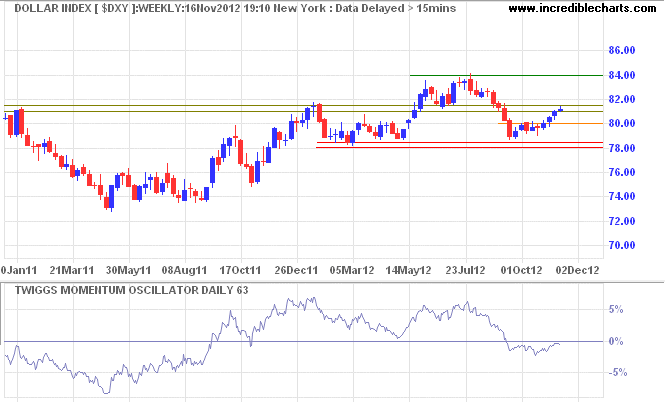The S&P 500 correction
By Colin Twiggs
November 16th, 2012 9:00 p.m. ET (1:00 p:m AET)
These extracts from my trading diary are for educational purposes. Any advice contained therein is provided for the general information of readers and does not have regard to any particular person's investment objectives, financial situation or needs and must not be construed as advice to buy, sell, hold or otherwise deal with any securities or other investments. Accordingly, no reader should act on the basis of any information contained therein without first having consulted a suitably qualified financial advisor. Full terms and conditions can be found at Terms of Use.
The S&P 500 correction continues despite the index finding short-term support at 1350. A rally would test the descending trendline around 1400 but a close below 1350 would signal another down-swing. Reversal of 63-day Twiggs Momentum below zero would indicate a test of primary support at 1275 (the index tends to move in increments of 25).

Of course, in nominal terms a dollar
is always worth a dollar. But in real terms, the value or purchasing power of a dollar
falls in half each time the cost of living doubles. During the period since the United
States left the gold standard in 1933, the price level has gone up nearly 18 fold; a
dollar in 2012 has less purchasing power than 6 cents in 1933. That sort of currency
depreciation is almost impossible under a gold standard regime. Indeed, the cost of
living in 1933 was not much different from what it was in the late 1700s. This is the
most powerful argument in favor of the gold standard.
~ Scott Sumner: The Case For Nominal GDP Targeting

Author: Colin Twiggs is a former investment banker with almost 40 years of experience in financial markets. He co-founded Incredible Charts and writes the popular Trading Diary and Patient Investor newsletters.
Using a top-down approach, Colin identifies key macro trends in the global economy before evaluating selected opportunities using a combination of fundamental and technical analysis.
Focusing on interest rates and financial market liquidity as primary drivers of the economic cycle, he warned of the 2008/2009 and 2020 bear markets well ahead of actual events.
He founded PVT Capital (AFSL No. 546090) in May 2023, which offers investment strategy and advice to wholesale clients.
